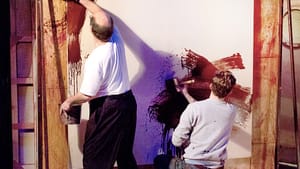Stay in the Loop
BSR publishes on a weekly schedule, with an email newsletter every Wednesday and Thursday morning. There’s no paywall, and subscribing is always free.
A lesson in how to look at art
John Logan's 'Red' at the Walnut Street Theatre

“What do you see?” — the first question asked in John Logan’s Red — is asked of both the actor and the audience. What do we see? The stage is filled with a large painting, two black lines on a red background, meant to represent the work of abstract expressionist Mark Rothko.
This Rothko, played by David Volin, is an arrogant, self-absorbed son of a bitch. “I am not your teacher,” he tells his studio apprentice Ken, the versatile Daniel Frederick, and then proceeds to teach both Ken and the audience about art and the artistic process. Volin gives a compelling performance, edged with cruelty and conviction, erupting occasionally into sadistic verbal outbursts to wound whoever is unlucky enough to be standing in front of him. Frederick is simultaneously subservient and rebellious.
“Red,” says Ken in answer to the opening question, and Rothko explodes. What is red? Is it scarlet, crimson, or some other color? “It’s sunrise,” says Ken, and the two are off in a duel of who can name the most reds: passion, rage, viscera, blood, Santa Claus.
Rothko can’t stop lecturing. It’s what makes the play fascinating and sometimes a bit tedious. He sees himself as one of the great artists of the ages. “Rothko and Rembrandt,” he muses. “Dionysus and Apollo,” offers Ken, who has been driven by his mentor’s insults to read Nietzsche’s The Birth of Tragedy. What the artist fears, Rothko warns Ken, is not the blank page, “he fears Manet.”
Who is worthy?
“Who is worthy to see your art?” challenges Ken after two years of submitting to his mentor’s whims and rages. Rothko’s paintings, the artist asserts, need the viewer in order to exist. Why then has he agreed to paint murals at the Four Seasons? Diners will barely look at his work in the upscale restaurant in the new Seagram building. He wants his art to engage the viewer but, it seems, he also wants to upset those who dine in this temple of consumerism.
It’s unclear whether Rothko realized he was making art for the restaurant, or whether he thought it was for the lobby of the prestigious new building designed by Mies van der Rohe and Phillip Johnson. Whatever he thought, he feared the success that turns an artist into a commodity. He hated the idea that he might be an “overmantle,” the sort of art that one buys to enhance the décor.
The play hints at death throughout. Rothko is afraid that “the black will overtake the red.” Ken is saddled with an absurd backstory of family murder that does little to advance the character or the plot except as fodder for Rothko’s cruelty. Rothko refers to Jackson Pollock’s death in a speeding car as “a lazy suicide,” and hints at his own demise in 1970, a suicide in his studio surrounded by the red of his own blood.
The artist at work
The play is set in an artist’s studio (the set design is by Roman Tatarowicz) where Rothko works on the paintings — which would eventually number 30 — from which he plans to select seven to be displayed in the restaurant. (This never happened. He withdrew from the commission, sent back the money, and just before his death sent some of the paintings to the Tate Gallery in London.) There is no natural light, reflecting Rothko’s dislike of it. The paintings are large and the stage is small, so there is some awkward movement around exchanging one painting for another, which also gives the feeling of an artist at work.
One of the highlights of the play occurs when the two artists prime a canvas in the deep maroon that Rothko used as the backdrop for his art at the time. It’s a moment of almost balletic intensity and does the one thing that most plays about artists don’t — believably depict the artist at work.
What doesn’t quite work is a scene of emotional connection between two wounded men in which Rothko, for once, actually sees the person standing in front of him. That connection is marked by a hug, which undercuts the moment; a failure to touch might have been more powerful.
In the play, Rothko gloats over how abstract expression wiped out cubism and surrealism, but resents that pop art has taken over and edged him out. The show is well-timed in the cultural context of Philadelphia, making reference, inadvertently, to two exhibits currently in town: Picasso: The Great War, Experimentation and Change at the Barnes Foundation and International Pop at the Philadelphia Museum of Art.
It’s worth taking a look at all three and asking yourself, “What do I see?”
For Steve Cohen’s review of the Picasso exhibit at the Barnes, click here.
For commentaries on the 2011 prouction of Red by Philadelphia Theatre Company, begin here.
What, When, Where
Red. By John Logan. Dan Olmstead directed. Through March 20, 2016 at Walnut Street Theatre Independence Studio on 3, 825 Walnut St., Philadelphia, PA. 215-574-3550 or walnutstreettheatre.org.
Sign up for our newsletter
All of the week's new articles, all in one place. Sign up for the free weekly BSR newsletters, and don't miss a conversation.
 Naomi Orwin
Naomi Orwin